Septoria tritici blotch - risk and management considerations for 2024
Septoria tritici blotch - risk and management considerations for 2024
Author: Brad Baxter (NSW DPI), Ben Ovenden (NSW DPI), Steven Simpfendorfer (NSW DPI), Andrew Milgate (NSW DPI) | Date: 14 Feb 2024
Take home message
- Favourable climatic conditions early in the growing season of 2023 resulted in the widespread and increased prevalence of Septoria tritici blotch (STB) in southern NSW (sNSW)
- With resultant high stubble loads from the 2021 – 2023 seasons, STB risk levels are likely to be elevated again in 2024
- STB infection and epidemic development is highly dependent on climatic conditions throughout the season. Climatic conditions in 2024 will dictate the severity of any STB epidemic.
- If optimal climatic conditions are experienced and early STB infection is evident, apply fungicide at GS31 to suppress the epidemic and enable flexibility with later fungicide applications
- Not all fungicide active ingredients are equal when it comes to controlling STB and fungicide choice is becoming increasingly important
- NSW DPI plant pathologists can assist with correct diagnosis and advice on appropriate integrated disease management (IDM) options.
Introduction
Septoria tritici blotch (STB) is a necrotrophic disease of bread wheat, durum wheat and triticale, caused by the pathogen Zymoseptoria tritici (Z. tritici). STB is considered the third most significant wheat disease globally, threatening large areas of wheat production. Studies at the Wagga Wagga Agricultural Institute (2020 to 2021) revealed that in regions with moderate to high rainfall, the disease could lead to a considerable reduction in crop yield, ranging from 19% to 49%.
STB has a fungal structure produced on wheat stubble (pseudothecia), which releases airborne spores (ascospores) under ideal environmental conditions. The ascospores produced can spread over long distances (kilometres) on the wind to infect susceptible crops. Following an infection event, lesions appear up to 28 days later and produce pycnidia (small black structures inside tan leaf lesions that give a speckled appearance). The pycnidia produce a different type of spore called conidia, which are then splash-dispersed by rainfall within the wheat canopy, causing new infections and further driving the STB epidemic.
Under the NSW DPI project DPI2207-002RTX with co-investment from GRDC, diagnostic and management advice services are offered at no cost to growers and advisors. STB, for the third year in a row, was the fourth most queried disease during 2023 (data not shown), further emphasising the importance of this disease in southern and central NSW.
Septoria epidemic during the 2022 and 2023 growing seasons
The start of the 2023 growing season for much of southern New South Wales (sNSW) was characterised by widespread STB infection in the lower canopy of susceptible wheat varieties. However, unlike 2022 this early infection did not generally progress to the upper canopy during grain filling nor result in significant yield loss. Several climatic and management differences during 2023, as opposed to 2022 can help explain this.
STB development is highly driven by climatic conditions and requires extended periods of leaf wetness (>24 hours) and optimal cycling temperatures for infection of 15-20°C. There was below-mean rainfall during winter and spring at Wagga Wagga in 2023 (Figure 1). The long-term cumulative historical mean annual rainfall for August, September and October at Wagga Wagga is 129.9 mm. During 2022, the rainfall received during that period was 335.2 mm compared with only 61.8 mm in 2023. These three months are crucial for the development of STB epidemics, as this is when STB moves from the lower to mid-canopy onto the upper leaves (Flag, Flag-1, Flag -2). This is important because the upper leaves contribute the most to yield accumulation. The 2023 spring rainfall during those critical months was less conducive to STB cycling than in 2022, resulting in reduced STB infection levels in the mid and upper canopy of wheat crops.
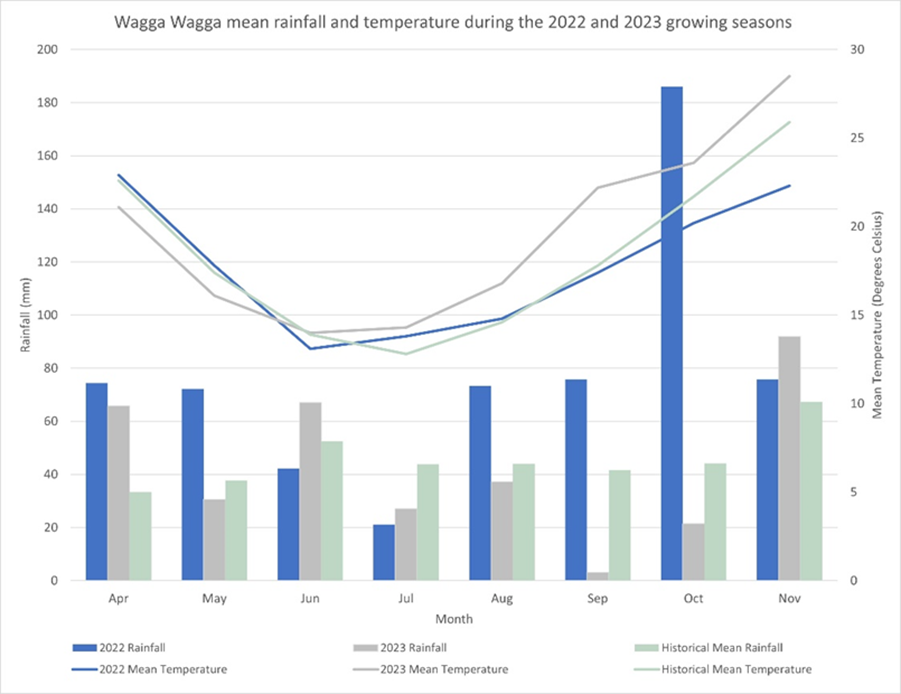
Figure 1. The growing season (April to November) rainfall and temperature during 2022 and 2023 as compared with the long-term mean monthly rainfall and temperature. The halt in STB infection levels during the second half of the 2023 growing season can be explained by the below mean rainfall and above mean temperatures during winter and spring months, particularly September and October (BOM, 2023).
The mean temperature during the spring months of 2023 was much higher than 2022 (Figure 1). The deviation from historical mean temperature for August, September and October during the 2022 and 2023 growing seasons are outlined in Table 1. In 2022, temperatures were much cooler, facilitating STB infection and cycling, whereas 2023 temperatures were outside the ideal cycling temperatures for STB development much earlier in the season and resulted in shortened leaf wetness duration. These factors reduced the number of cycles STB could undertake in 2023, helping to curb the levels of infection despite the extreme inoculum loads that had built up during the previous 2–3 years.
Table 1. Deviation from historical mean temperatures for August, September, and October 2022 and 2023.
Month | Historical mean temperature (°C) | 2022 deviation from historical mean temperature (°C) | 2023 deviation from historical mean temperature (°C) |
|---|---|---|---|
August | 14.6 | +0.2 | +2.2 |
September | 17.8 | -0.4 | +4.4 |
October | 21.7 | -1.5 | +1.9 |
Temperature and rainfall are key factors that drive disease epidemics. However, for STB infection, leaf wetness and importantly the duration of leaf wetness also play a crucial role. The number of rainfall days and the consecutive number of rainfall days (greater than 2 days) during the growing seasons of 2022 and 2023 are outlined in Figure 2. A rainfall day is categorised as a fall of >5 mm in a 24-hour period and/or >5 mm falling during a single event over consecutive days (>2 days)
During the crucial three months for disease development – August, September and October – there is significantly less rain days along with less consecutive rainfall days in 2023 compared with 2022. For example, September 2022 had four rainfall events that lasted greater than two days, compared to zero during September 2023. October 2022 had three, and October 2023 had one rainfall day. This limitation in leaf wetness duration meant that the moisture requirement for STB to cycle was only partially met or not met at all, resulting in a net reduction in infection levels in 2023.
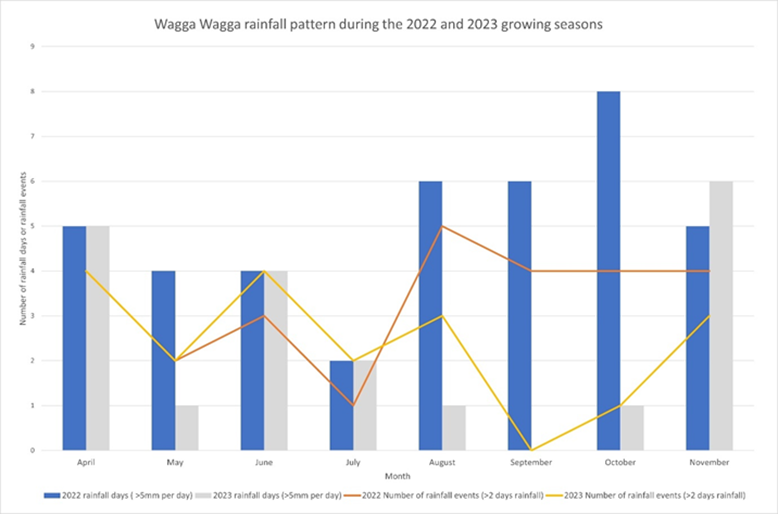
Figure 2. The growing season (April to November) number of rainfall days and number of consecutive rainfall days (>2 days) in 2022 and 2023 at Wagga.
Generally, the lack of rainfall, decrease in leaf wetness duration, higher-than-average temperatures and proactive fungicide use all contributed to STB staying in the lower to mid canopy of wheat crops in sNSW during the 2023 season. This was not the case for the entire cropping area of sNSW, particularly in the higher rainfall slopes regions, where STB continued to be a problem throughout the entirety of the 2023 season.
Septoria tritici blotch (STB) management considerations for 2024
Even though STB did not pose a major threat in many regions in the latter half of 2023, the inherent risk moving forward is still elevated. An integrated disease management (IDM) system, comprised of the factors outlined below, should be implemented to reduce the risk of economic losses.
Stubble colonisation and associated management considerations
Stubble spore release experiments assessing plant resistance rating and time of sowing on ascospore release of pathogens Z. tritici (STB) and Pyrenophora tritici-repentis (Yellow leaf spot, YLS)were conducted at Wagga Wagga Agricultural Institute during 2020 and 2021 (Figure 3). Results have shown that the resistance rating of the wheat variety grown has little influence on the ability of these pathogens to colonise senescent stubble and inoculum levels produced off retained stubble, i.e., the number of spores released, in the following season.
There was no significant difference (P = 0.05) between the four sowing dates, or within a sowing date between varieties, in the number of Z. tritici and P. tritici-repentis ascospores released from stubble (Figure 3). In the case of STB, this means that a moderately resistant (MR) rated variety is statistically releasing the same number of ascospores in the following season as varieties rated moderately-resistant to moderately-susceptible (MR–MS), moderately susceptible (MS), susceptible (S) or susceptible to very-susceptible (S–VS). Essentially, the resistant rating of the plant does not carry over to ascospore release in the following season from the retained stubble. It is not known if the numerical differences in ascospore release numbers between variety resistance ratings, although not significant, have an influence on epidemic severity.
Therefore, any infected stubble from 2021–2023 must be considered a risk for the following wheat crop or crops nearby.
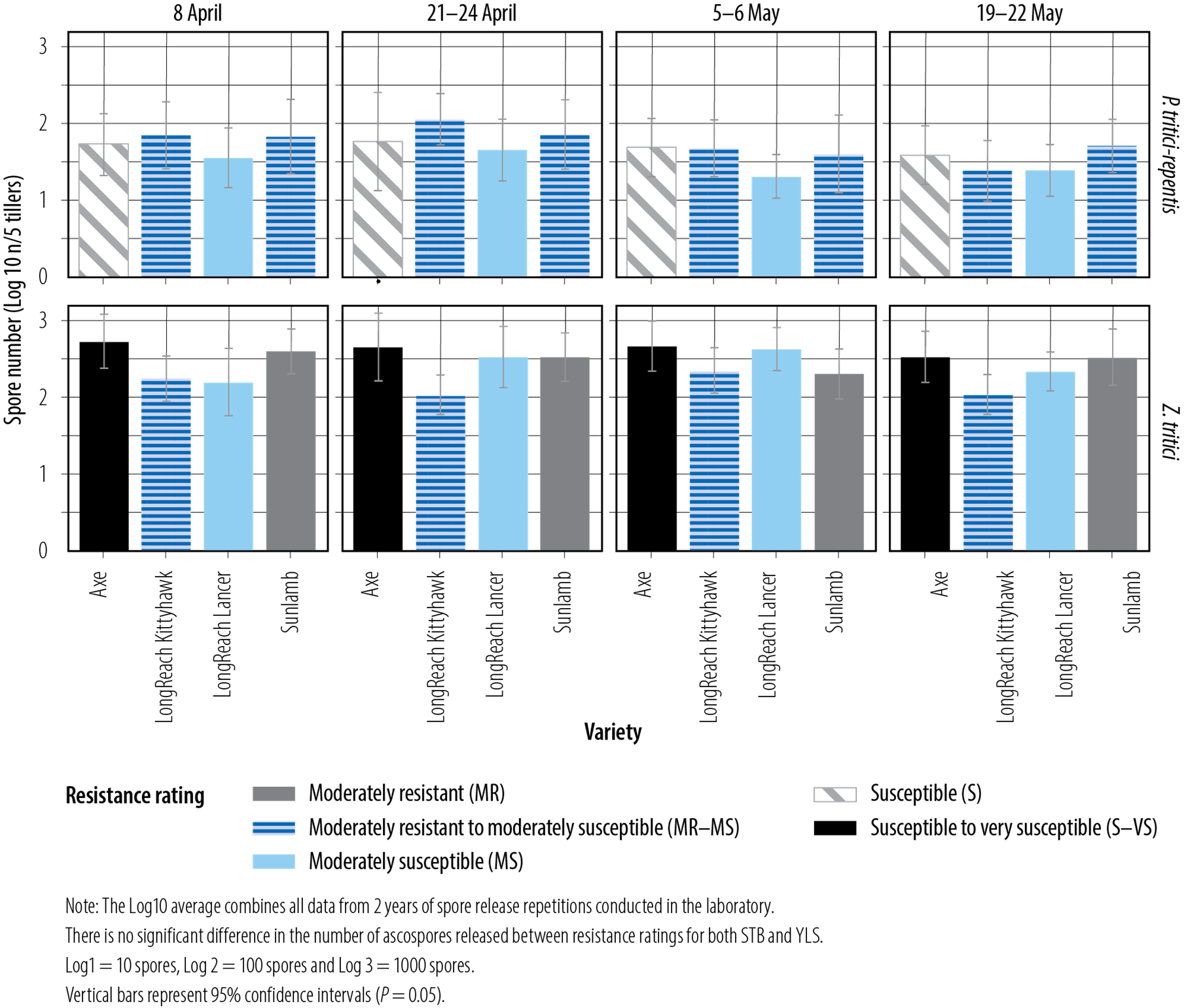
Figure 3. The average number of Zymoseptoria tritici and Pyrenophora tritici-repentis ascospores (Log10) released from wheat stubble of four varieties with different resistance ratings to the diseases Septoria tritici blotch (STB) and yellow leaf spot (YLS). Varieties mentioned in the graphs above are protected under the Plant Breeders Rights Act 1994.
Furthermore, findings from other experiments (data not shown) indicated that stubble infected with the STB-causing pathogen Z. tritici can generate enough ascospores to initiate an epidemic two years after the wheat crop was grown, irrespective of the varietal resistance rating. This has important implications for crop sequences and stubble management. In sNSW, the cropping sequence is dominated by cereal–canola–cereal rotations. As infected stubble can produce ascospores at an epidemic-inducing level for up to 2 years, it suggests that a single break crop such as canola, might not be enough to reduce the risk of STB or YLS infection. If possible, avoid sowing wheat-on-wheat. If you are forced into a situation where this must happen, plan an IDM program to reduce the risk of yield loss.
Stubble management experiments have demonstrated that a net reduction in inoculum levels can be achieved by manipulating harvest cut height to reduce the standing stubble available for the STB pathogen to colonise (Figure 4). These experiments included three cut height treatments: 32 cm (high), 24 cm (medium), and 14 cm (low). Cut heights were selected to reduce stubble length by one node on the main stem. Using the 32 cm cut height as a baseline, lowering the cut height to 24 cm reduced the number of ascospores produced by 84%. When comparing the 32 cm cut height to the 14 cm cut height, there was a 97% reduction in the number of ascospores released from the stubble.
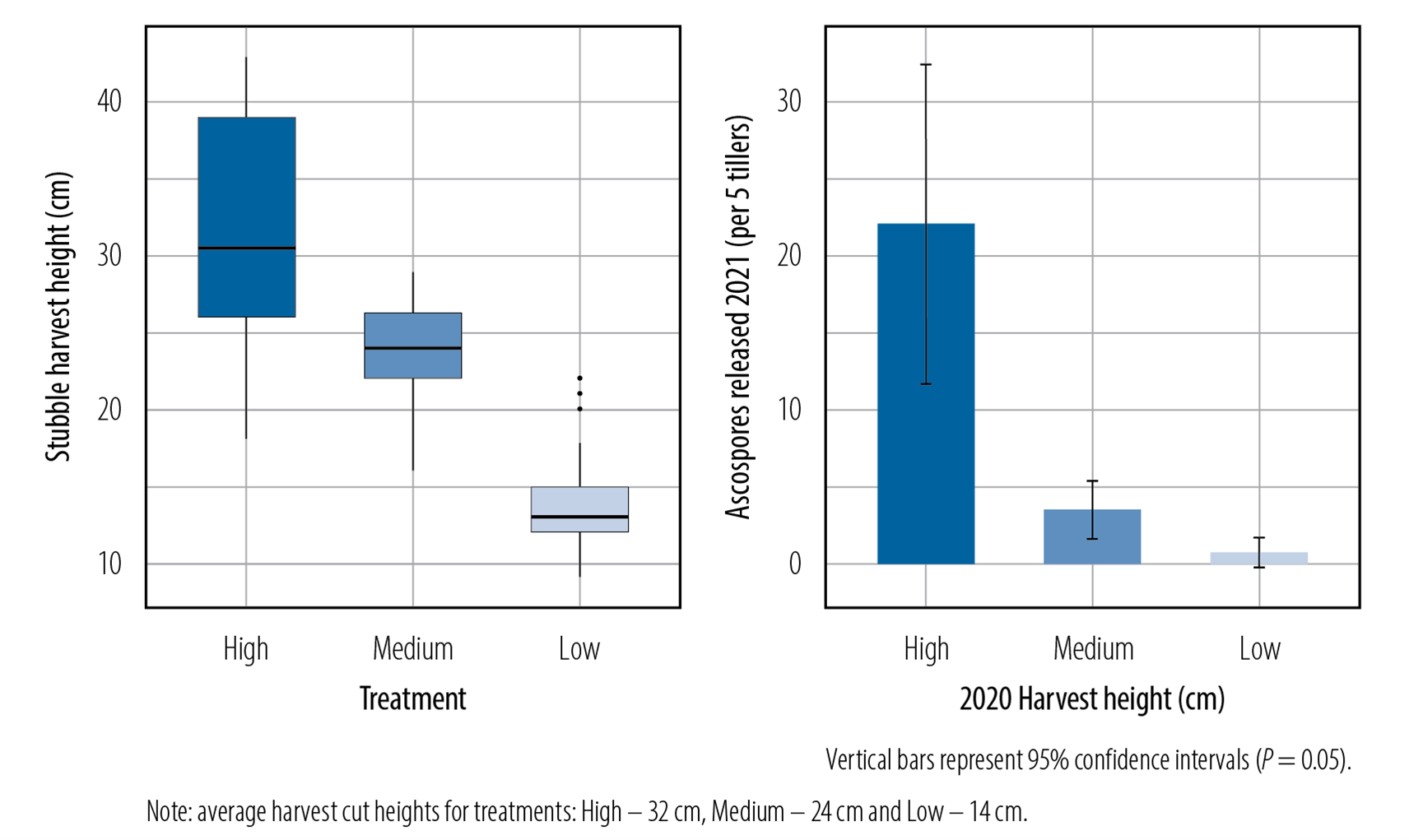
Figure 4. Left: Box plot showing the harvest cut height in centimetres (cm) of the high, medium, and low treatments for the 2020 STB stubble management experiment. Right: The number of Zymoseptoria tritici ascospore released from five tillers from the three stubble cut height treatments. This figure displays the reduction in ascospore numbers as the harvest cut height decreases.
The excess material must be removed from the paddock to result in a net reduction. Otherwise, the inoculum from the standing stubble is only relocated to the ground, which maintains the same inoculum levels within the paddock. Removal can be through baling or burning the stubble. However, the cost benefit risks of each method and other system impacts must be weighed before being undertaken.
Finally, the distinction needs to be made between managing disease in the current wheat crop to minimise yield loss and inoculum risk from the stubble in subsequent seasons. Even though the number of ascospores released from the senescent stubble does not significantly change with varietal resistance rating, variety choice remains critical to minimising losses from STB and other diseases within the growing season.
Variety selection
Research undertaken at Wagga Wagga Agricultural Institute confirms that a more resistant variety develops less disease compared with a more susceptible variety. In the absence of fungicide use, the difference in infection levels between a moderately susceptible (MS) variety and a susceptible to very susceptible (S-VS) variety with an early May sowing time can be as much as 30% less in the MS variety, resulting in a reduction of 10 – 15% in yield loss compared to the SVS variety (data not shown).
Choosing a wheat variety with a higher resistance level will protect yield in the presence of STB, while also reducing the number of fungicide applications required. This in turn decreases machinery, labour, and input costs. Minimising fungicide use also lowers the risk of fungicide resistance developing within both target and off-target fungal pathogen populations.
It is important to stay up to date with the latest variety resistance ratings as they can change from year to year. These ratings are developed through the National Variety Trial (NVT) pathology screening project and are released annually on the GRDC website (https://nvt.grdc.com.au/) and in state-based sowing guides such as the NSW DPI winter crop variety sowing guide.
Fungicide application
Not all fungicide active ingredients are equal when it comes to controlling STB, and fungicide choice is becoming increasingly important. The geographical spread of samples sent to Curtin University’s Centre for Crop and Disease Management (CCDM) for fungicide resistance screening in 2022 is displayed in Figure 5. A further 22 samples were sent from NSW in 2023 which at the time of writing results were not available. Primarily, the 2022 results reveal that the G143A mutation, which confers resistance to Group 7 (Qol, strobilurin) fungicides such as azoxystrobin, was not detected in any of the samples submitted from NSW.
However, the G143A mutation was detected in an STB sample from Tasmania in 2022 (not shown), marking the first detection outside of South Australia. It is unclear if this is the result of gene flow (wind dispersion) or an independent mutation event. This detection should act as a warning for NSW growers to use fungicide resistance management strategies to prolong the effectiveness of Group 7 (QoI, strobilurin) chemistry against STB.
Unsurprisingly, mutations that confer reduced sensitivity to Group 3 fungicides (DMI, triazoles) were found in all the samples except one from NSW. Specifically, the mutation called Cyp51 G1 (formerly identified as Cyp51 Isoform 11) was present in most leaf samples. This mutation is particularly significant because it leads to elevated levels of reduced sensitivity to some Group 3 fungicides such as tebuconazole, flutriafol and propiconazole. It is not unexpected since Cyp51 G1 was the predominant mutation in the STB population from a previous NSW study conducted in 2016.
These results support our recommendation that Group 7 (QoI, strobilurin) fungicides are effective in preventing STB infection in NSW. We continue to advise that if your goal is to specifically target STB curatively with fungicides, it is best to avoid using cheaper Group 3 triazole actives like tebuconazole and propiconazole. Instead, opt for stronger Group 3 fungicides such as prothioconazole or epoxiconazole.
Decision support matrix and suggested fungicide regime for STB management if the 2024 season is conducive to infection and disease development is outlined in Table 2. The table also outlines the efficacy status of any fungicide application on stripe rust, as many fungicides registered for use on STB will also have efficacy on stripe rust. There is very little data showing a yield benefit from using fungicides prior to the commencement of stem elongation. That said, any sprays applied before the commencement of stem elongation will at best only have a suppressive effect on inoculum load, as none of the leaves that contribute significantly to grain yield emerge until after this growth stage. Therefore, crops which include a fungicide with the herbicide application during tillering (GS25) still require a dedicated fungicide spray at GS31-32 to protect the Flag-2 leaf. All applications may not be needed depending on seasonal conditions, growth stage, infection levels and economic considerations. Particularly if fungicide treatments are applied to seed and/or flutriafol is applied to the fertiliser to protect seedlings from early STB or stripe rust infection.
Table 2. Decision support matrix and suggested fungicide regime for STB management if the 2024 season is conducive to infection and disease development. The table also outlines the efficacy status of fungicide applications on stripe rust.
Growth stage (GS) | STB present | Fungicide application required | Fungicide activity on stripe rust? |
|---|---|---|---|
GS 25 | Yes | No | Flutriafol activity if used |
GS 31 | Yes | Yes* | Yes |
GS39 | Yes | Yes/No* | Yes |
GS50-59 | Yes | Yes/No* | Yes |
*All applications may not be needed pending seasonal conditions, growth stage, infection levels and economic considerations. | |||
If the 2024 season is not conducive to STB development, and stripe rust is the primary foliar fungicide application target, consider products containing active ingredients such as tebuconazole or propiconazole to alleviate the selection pressure on prothioconazole and epoxiconazole after repeated use patterns during the 2021–2023 growing seasons. In dry conditions, fungicide applications may not be needed at all.
The 2022 results reiterate the need to protect fungicide modes of action when targeting all pathogens, but particularly those prone to developing resistance to diseases such as STB and wheat powdery mildew. To help prolong the life of fungicides, avoid susceptible varieties, implement crop rotation, consider non-chemical means of controlling inoculum sources, get a correct diagnosis if in doubt before applying a fungicide, rotate fungicide active ingredients and groups, adhere to label rates and use patterns. Further resistance management advice can be found at the AFREN website.
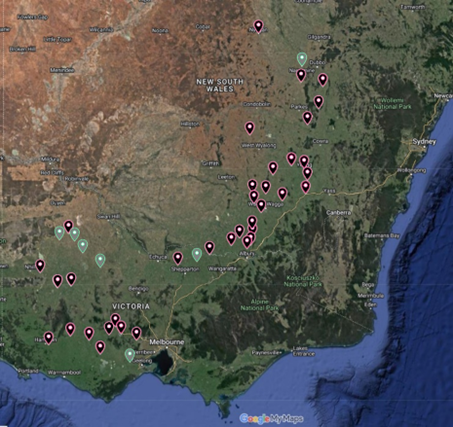
Figure 5. STB fungicide resistance screening results across NSW and Victoria in 2022. Note: Not all samples submitted appear on map, as some leaf samples did not recover DNA of high enough quality to be used for screening. Grey indicates the absence of Cyp51 G1 (Isoform 11). Black indicates the presence of Cyp51 G1 (Isoform 11) Group 3 (triazole) resistance. Courtesy of CCDM.
Conclusions
With high wheat stubble loads from high yielding years from 2021 through to 2023, the STB inoculum risk for next season is elevated. However, incidence of STB is highly dependent on climatic conditions and 2024 growing season conditions will dictate the severity of any epidemic. To help counter these factors, components of the research outlined above can be implemented into an IDM plan to suppress and control STB. Acknowledging the risk and duration of the risk (i.e., >2 years) that any STB infected stubble can have on subsequent cereal crops can guide crop rotation decisions. If growing wheat on wheat, a plan can be implemented to appropriately manage the risk of STB, but it is best avoided. Cultural practices, such as variety selection, stubble cut height and stubble removal should be used in the first instance to reduce the resistance pressure on fungicides and prolong their effective lifespan.
NSW DPI is here to support growers with correct diagnosis and discussions of management options prior to sowing and as required throughout the season.
Acknowledgements
The research undertaken as part of these projects is made possible by the joint investment of NSW DPI and GRDC, and the significant contributions of growers and their advisers through both sample submission and engagement. The authors would like to thank them for their continued support. The authors would also like to express gratitude to cereal pathology staff members located at Wagga Wagga and Tamworth for their valued contributions to project work. Additionally, the authors acknowledge the ongoing support for cereal pathology capacity by NSW DPI.
References
BOM,2023. Historical climate data. Accessed 11/12/23.
Useful links
NSW DPI research result booklets
Contact details
Brad Baxter
NSW DPI, Pine Gully Rd, Wagga Wagga, NSW 2650
Ph: 0428 294 121
Email: brad.baxter@dpi.nsw.gov.au
Twitter: @BradBaxter1985 or @NSWDPI_AGRONOMY
Steven Simpfendorfer
NSW DPI, 4 Marsden Park Rd, Tamworth, NSW 2340
Ph: 0439 581 672
Email: steven.simpfendorfer@dpi.nsw.gov.au
Twitter: @s_simpfendorfer or @NSWDPI_AGRONOMY
Andrew Milgate
NSW DPI, Pine Gully Rd, Wagga Wagga, NSW 2650
Ph: 02 6938 1990
Email: andrew.milgate@dpi.nsw.gov.au
Podcasts
NSW DPI podcasts: are now on popular streaming platforms, such as Apple and Spotify. Just search for NSW DPI Agronomy. Alternatively, you can subscribe and receive NSW DPI podcasts on Soundcloud Stream NSW DPI Agronomy | Listen to podcast episodes online for free on SoundCloud.
Date published
February 2024
Varieties displaying this symbol beside them are protected under the Plant Breeders Rights Act 1994.
GRDC Project Code: DPI1706-010BLX, DPI2207-002RTX, DPI1807-012BLX, DPI1807-011BLX,
